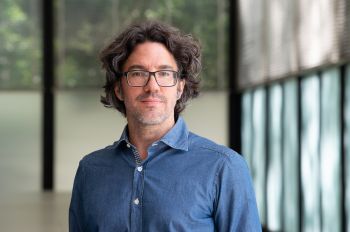Dining Pavilions Designed and Built by Students, Alumni, and Faculty Provide Social Distance During COVID-19 Pandemic

As some Chicago restaurants and businesses struggle to reopen during the COVID-19 pandemic, the All Reimagining Chicago Task Force––composed of city departments, community organizations, and design professionals––aims to provide new infrastructures and resources to businesses on the West and South sides of the city to simultaneously drive more traffic to these businesses and facilitate social distancing.
One of the task force founders is Mark Sexton (B.ARCH. ’80), an Illinois Institute of Technology College of Architecture alumnus and Board of Advisors member, a trustee at Illinois Tech, and a member of the Board of Directors for the Chicago Architecture Biennial. Sexton, along with fellow CAB Board of Directors member Sarah Herda, began the task force as a way to engage with the city and make the Biennial more visible during its off years. But the group evolved into ARC as the COVID-19 pandemic took its toll on the city.
“This pandemic is one of the biggest things to happen to the city of Chicago, and architects can have a real profound effect,” says Sexton. “This notion of health and safety? As architects we can provide that, especially on the South and West sides.”
Sexton called on College of Architecture Adjunct Professor Vladimir Radutny, who, together with students Daniel Allen (B.ARCH. 4th Year) and Jeisson Rodriguez-Arias (B.ARCH. 4th Year), took part in the task force to provide assistance to the restaurants.
“I wanted to make something useful out of this summer despite its challenges,” says Allen. “This was the perfect opportunity to put into practice some of the skills I developed in school while making change for a typically underserved community, and a chance to explore an idea that could potentially make a real impact.”
To provide restaurants with expanded options for outdoor seating, the three designed and constructed a wooden dining pavilion roughly the size of a parking space. To make the structure as easy and affordable to produce as possible, they constructed it entirely from two-by-six lumber. A number of other students assisted in the construction of the pavilion, too.
“The idea was to have an easy-to-assemble piece,” says Rodriguez-Arias. “You can go to a Home Depot or Menards and get these two-by-six members, and with our construction documents you can build as many as you can afford to make.”
Moreover, the structure provides patrons with seating and eating surfaces—both benches and bar-height counters for standing—as well as a roof to shelter them from the elements. The columns of the structure are placed eight feet apart so that two groups of diners can simultaneously use the space while remaining appropriately distant.
“We tried to create a space that is interactive, where architecture can offer social comfort and flexibility for how people use it,” says Radutny. “We knew we can’t define or predict all the possibilities and arrangements for individual dining, therefore the perimeter bench seating gave us the opportunity to achieve the seating flexibility. The taller bar section gives more informal dining options for patrons. We called this structure a social pavilion for a reason: it acts more as a device for interaction.”
Though just a prototype, the pavilion—initially built on the Illinois Tech campus—is now installed in front of Original Soul Vegetarian. Founded in 1983 and family owned ever since, it is one of the nation’s oldest vegan soul-food restaurants and a fixture of Chicago’s Chatham neighborhood.
“I feel great about it. It’s a conversation piece, and a lot of people adore it,” says Arel Brown, who co-owns Original Soul Vegetarian with his sister Lori Seay. “I like that college students did it, and I thought that would be a great thing to bring to the community. The size of it is perfect, not too big and not too small. It's pure wood, so to me it goes with everything that we’ve established here over the years: promoting a healthy lifestyle.”
In addition to the shelter created by Radutny and his students, a team at Krueck+Sexton architects comprising College of Architecture alumni Boram Oh (B.ARCH. ’20) and Sanghyo Kim (M.ARCH. ’19) created another shelter design installed at 75th Street. Called the Nest, the shelter takes on a circular profile, made from a lumber structure clad in blue Plexiglass to provide shelter. More compact, it’s designed to house one dining party at a time.
“When we designed the Nest, we focused on how it can remain with the community in the long term and how it can be deployed as easy and fast as possible without having an architecture background. It’s as easy as assembling IKEA furniture,” says Oh. “This is a hard time for everyone to go through, and I hope the Nest project sends a message to the community that we’ll get through it together.”
“We’re pleased to be able to support small businesses through ARC,” adds Kim. “This difficult situation is not unique to Chicago, and I hope that the Nest can be a good example to other areas and cities.”
On September 5 the City of Chicago had an opening ceremony for the corridor of businesses along 75th Street where the College of Architecture and Krueck+Sexton-designed shelters are now in place.
“How can we bridge this gap that’s always been there but has become incredibly apparent lately? These are two structures that won’t solve the inequities,” says Sexton. “But showing a purpose and inventiveness––that’s where the potential of this project lies.”
Photo: The wooden dining pavilion that Illinois Institute of Technology students Daniel Allen and Jeisson Rodriguez-Arias helped design and construct on Mies Campus

Design with a Purpose
Illinois Tech student, alumni, and faculty combined to create pavilions that are placed outside and promote social distancing, helping small businesses on the South and West sides of Chicago.









